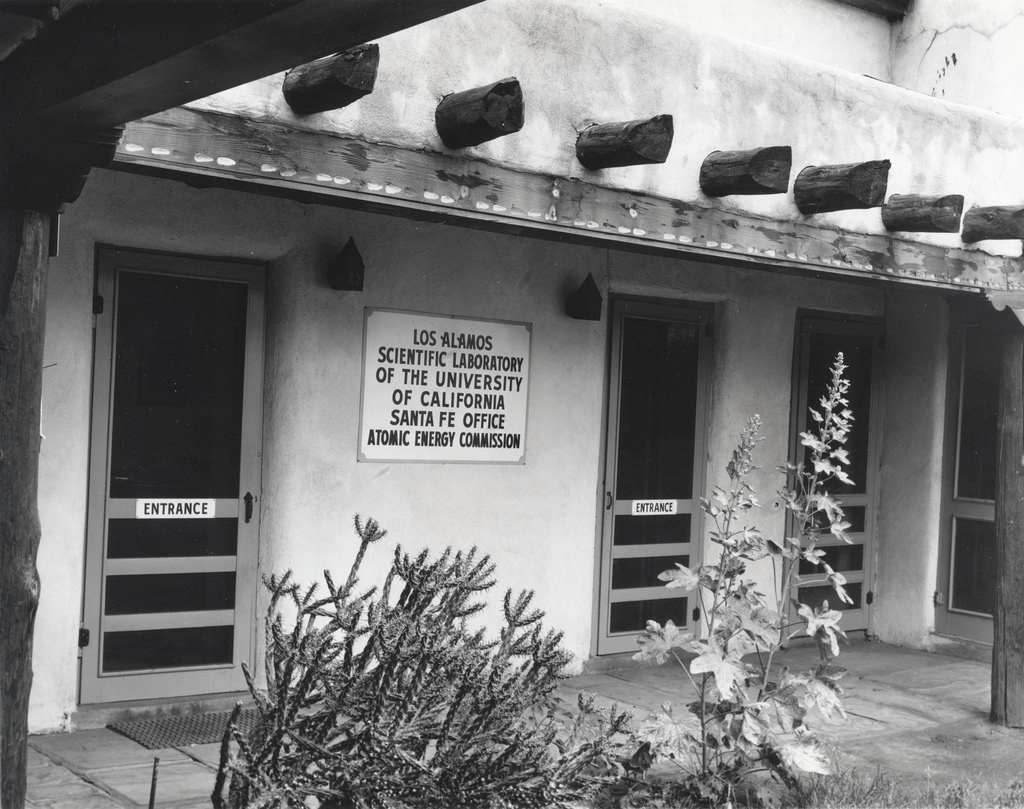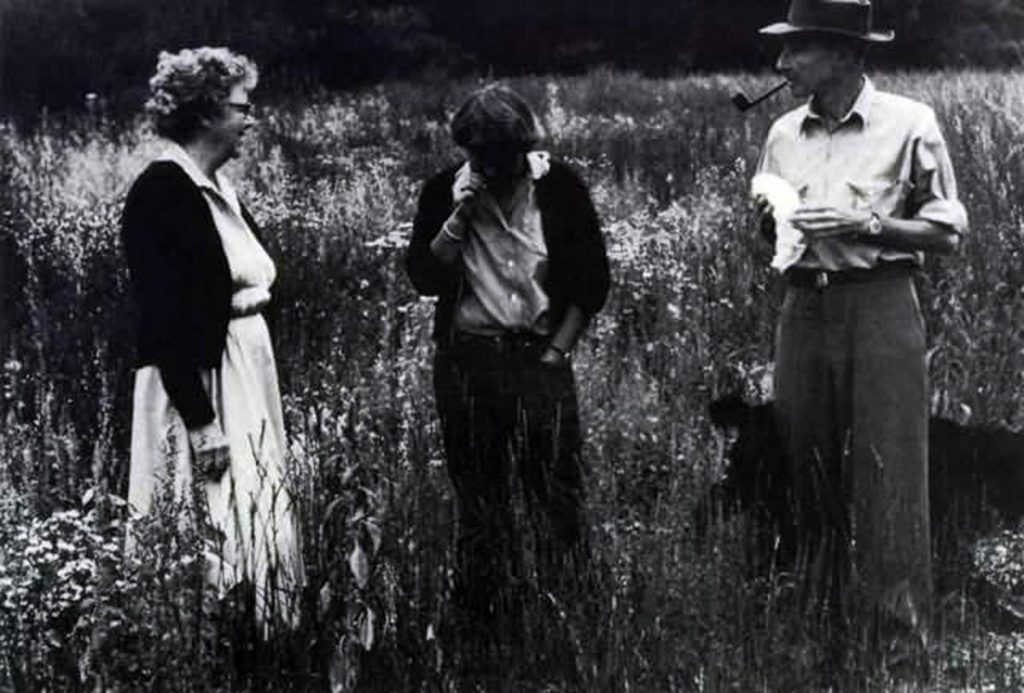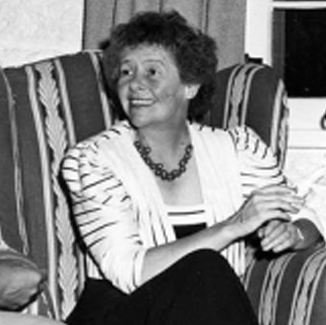In November 1942, General Leslie R. Groves and Berkeley physicists Edwin McMillan and J. Robert Oppenheimer travelled to Los Alamos, New Mexico to survey what would become the site for Project Y, the top-secret effort to build the world’s first atomic bomb.
Four months later, when the heavy snows had melted and the spring rains turned the desert ground to mud, Oppenheimer returned to Los Alamos with a small team of physicists to begin organizing the laboratory. Upon their arrival, the group stopped at the La Fonda, an inn and a favorite watering hole in Santa Fe since 1922. Standing in the lobby, Oppenheimer’s unusual looks—his brown gabardine suit and porkpie hat—caught the attention of a single mother searching for a job that would make a difference in the war effort. Her name was Dorothy Scarritt McKibbin.
Born in Kansas City, Missouri in 1897, McKibbin first visited New Mexico in 1926 when her doctor sent her to Santa Fe to recover from tuberculosis. In 1927, she married Joseph McKibbin and had a son, Kevin, in 1930. When her husband died tragically in 1931, Dorothy returned to Santa Fe with her son.
“I loved the artists and the beauty of the surroundings and the climate,” recalls McKibbin in a never-before-heard 1965 interview with author Stephane Groueff. “There’s something about this altitude of 7,000 feet that comes right up from the ground into my feet and out through my head and goes up; it stimulates me.”
Meeting Oppenheimer
 McKibbin, a part-time bookkeeper at the Spanish and Indian Trading Company in Santa Fe, began searching for another job when the Company was liquidated in 1943. After applying to work at the local bank, McKibbin ran into Joe Stevenson, an old friend from Santa Fe who had met Oppenheimer while taking courses at Berkeley. Stevenson had returned with him to help organize housing for incoming scientists.
McKibbin, a part-time bookkeeper at the Spanish and Indian Trading Company in Santa Fe, began searching for another job when the Company was liquidated in 1943. After applying to work at the local bank, McKibbin ran into Joe Stevenson, an old friend from Santa Fe who had met Oppenheimer while taking courses at Berkeley. Stevenson had returned with him to help organize housing for incoming scientists.
“He asked me if I would like to be a secretary for a housing project in Santa Fe,” remembers McKibbin. When she tried to find out more about the position, Stevenson “wouldn’t tell me a thing.” With an offer from the bank already on the table, Stevenson gave her twenty-fours hours to decide if she wanted the job.
The next day, while having lunch with friends at La Fonda, McKibbin saw Stevenson in the lobby chatting with a tall, unusual-looking stranger. “He had on a trench coat and a pork-pie hat,” she remembers. “He walked sort of on the balls of his feet. I think that he had a pipe in his mouth.”
When the men approached to introduce themselves, McKibbin was mesmerized. “I did not get the name; I wouldn’t have known anything about it if I had,” she admits. “He said about five words and then he turned and went on. I turned to Joe Stevenson and said, ‘I’ll take the job.’”
Like so many others, McKibbin was captivated by Oppenheimer’s warm personality and delicate charm. “I thought that anything with which a man of that magnetism was connected was what I would enjoy.”
 On March 27, 1943 McKibbin moved into her new office at 109 East Palace Avenue in Santa Fe. The building, constructed as a Spanish hacienda in the 1600s, became the administrative hub of the Manhattan Project. To conceal its true purpose, Oppenheimer rented the office under a false name. “We had five offices around that patio,” says McKibbin. “He went under the name of Mr. Bradley and rented it from Mrs. Field, who owned the whole thing.”
On March 27, 1943 McKibbin moved into her new office at 109 East Palace Avenue in Santa Fe. The building, constructed as a Spanish hacienda in the 1600s, became the administrative hub of the Manhattan Project. To conceal its true purpose, Oppenheimer rented the office under a false name. “We had five offices around that patio,” says McKibbin. “He went under the name of Mr. Bradley and rented it from Mrs. Field, who owned the whole thing.”
Mrs. McKibbin was the first reassuring face that fatigued Manhattan Project recruits saw upon arriving in Santa Fe. “These young husbands and wives would come in with their babies on their shoulder and come into our office,” says McKibbin. “We’d say, ‘Hello’ and ‘How are you’ and take care of their baggage and see that they got a ride up to the Hill.”
McKibbin quickly became indispensable as the “Gatekeeper to Los Alamos.” As the Project continued to grow in the final months of 1943, 109 East Palace was flooded with new recruits from across the country. “We averaged about sixty-seven people in there per day and 110 telephone calls per day,” says McKibbin. “We were really very busy.” Her warm smile and engaging personality reassured new recruits that they would be taken care of. She also gained the confidence and respect of Oppenheimer, who invited her to attend private parties at his house on Bathtub Row in Los Alamos.
McKibbin could not help but notice Oppenheimer’s special relationship with Los Alamos. “He was much more at home out there in those deserts spots than any of the other men who were with him,” she recalls. “He loved this country. He’s a part of it. Everybody here loves him. The Indians love him! The natives love him! They feel that they can have access to him. They can talk to him.”
“First Lady” of Los Alamos
 As Los Alamos continued to grow, McKibbin became familiar with the range of personalities that worked on the Hill. “Otto Frisch played the piano beautifully,” she remembers. “Hans [Bethe] loved to ski; he was a mountaineer.” She even got to know Klaus Fuchs, the German theoretical physicist who passed information about the atomic bomb to the Soviet Union. “Everybody liked him very much. The wives thought he would be fine to babysit for them, which he often did.”
As Los Alamos continued to grow, McKibbin became familiar with the range of personalities that worked on the Hill. “Otto Frisch played the piano beautifully,” she remembers. “Hans [Bethe] loved to ski; he was a mountaineer.” She even got to know Klaus Fuchs, the German theoretical physicist who passed information about the atomic bomb to the Soviet Union. “Everybody liked him very much. The wives thought he would be fine to babysit for them, which he often did.”
For many Manhattan Project veterans, it was McKibbin’s friendliness and reassurance that made her one of the most beloved people on the Hill. “She was a very warm, generous, smiling woman who immediately put you at ease,” recalls Rebecca Bradford Diven, a chemist who worked on the Project. “She became a lifelong friend of everybody who ever went through her office.”
When couples at Los Alamos began to get married, McKibbin offered up her beautiful garden. “There must have been at least eight or ten weddings that were performed at Dorothy’s house during those two or three years,” remembers Kay Manley, whose husband John Manley helped organize Los Alamos during the early days. “She was a very great help, a very great help.”
When the first atomic bomb was dropped on Hiroshima on August 6, 1945, McKibbin finally realized what the physicists at Los Alamos had been working on. She remained there until her retirement in June 1963. In recognition of her contribution, McKibbin was awarded the title of “First Lady” of Los Alamos and declared a Living Treasure of Santa Fe.
For McKibbin, working on the Manhattan Project was an experience unlike any other: “There’s a glow that comes over every face when you speak about it. It’s much more than people who’ve gone back to a college reunion. It was the radiance of the intensity of the effort that all of those people, the husbands and the wives, made to make this go.”
For more information about Dorothy McKibbin and her role at Los Alamos, be sure to listen to her interview on Voices of the Manhattan Project and check out 109 East Palace: Robert Oppenheimer and the Secret City of Los Alamos by Jennet Conant.





